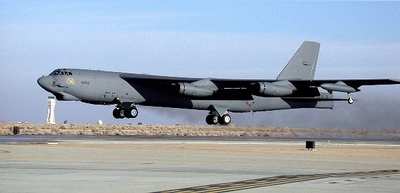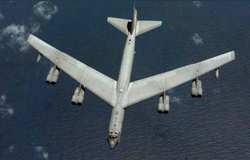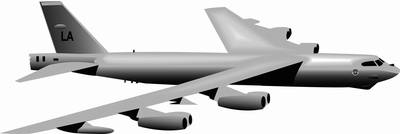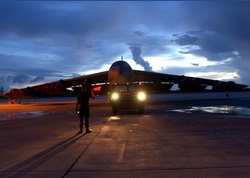B-52 Sees Biggest Improvement In 15 Years
After three years of planning, Air Force flight test experts at
Edwards AFB introduced a new offensive avionics system for the B-52
Stratofortress. Flight testing of the B-52 Avionics Midlife
Improvement, known as AMI, began in mid-December and is scheduled
to continue through March 2004, with 80 sorties averaging eight
hours long and several global missions planned to last more than 24
hours.

The AMI program is specifically designed to upgrade the B-52H
offensive avionics system and includes replacing the inertial
navigation system, the avionics control unit, the data transfer
system and all associated hardware and software.
"It is the biggest improvement to the B-52 in 12 (to) 15 years,"
said Maj. Ed Bellem, B-52 flight commander and AMI project pilot.
"AMI is a critical modification; an essential upgrade needed to
keep the B-52 airborne.
 "Processors equivalent to the Commodore 64 are being removed
and replaced with (Pentium II-level) processing capabilities,"
Bellem said. "This improvement will ensure the airplane knows where
it is at all times and can accurately deliver bombs on target."
"Processors equivalent to the Commodore 64 are being removed
and replaced with (Pentium II-level) processing capabilities,"
Bellem said. "This improvement will ensure the airplane knows where
it is at all times and can accurately deliver bombs on target."
As the main hub for all AMI flight testing, approximately 200
people at Edwards are dedicated to the program; however, the B-52's
avionics upgrade stretches far beyond the boundaries of the base.
Boeing's Wichita, Kan., division is responsible for the overall
development of AMI. Key players include people from the Boeing High
Desert Assembly Integration and Test Centers; the 419th Flight Test
Squadron and the Air Force Operational Test and Evaluation Center
at Edwards; the 49th Test and Evaluation Squadron at Barksdale Air
Force Base, La.; and the B-52 system program office at Tinker AFB,
Okla.
"Everybody is hustling to keep this program on track," said
David Siu, B-52 flight test manager and AMI project manager.
The $8.5 million effort is on time and on cost, but the schedule
is the greatest risk. "The fleet starts living off spare parts in
2004," said Bellem. "The current INS is becoming
unsupportable."

With the B-52 approaching its 50th anniversary, parts to repair,
maintain and replace are just not available, he said. Some of the
manufacturers are going out of business, while others are trying to
stay on the front end of technology, spending their money to
support new platforms as opposed to old ones, according to Siu. AMI
is not only needed to prevent capability loss caused by a lack of
vendors and non-supportable equipment, but the improvement will
also ensure compatibility with new and future weapon systems, he
said.
"Without this avionics upgrade, there is no way weapons coming
online today or in the future will be able to operate with the B-52
as their platform," said Maj. Merrice Spencer, a B-52 navigator and
chief of avionics and weapons integration.
 To
date, AMI is conquering these main system shortcomings and
performing as designed, said Bellem. "So far, the upgrade has been
almost transparent to us," he said, "but there has been a
significant improvement in reliability, which corresponds to
mission-capable rate."
To
date, AMI is conquering these main system shortcomings and
performing as designed, said Bellem. "So far, the upgrade has been
almost transparent to us," he said, "but there has been a
significant improvement in reliability, which corresponds to
mission-capable rate."
The average time between aircraft need extensive repairs has
increased from an average of 700 hours to an average of 7,500
hours. AMI's extensive flight-test schedule is based on the
capability of the B-52 itself. The aircraft can carry a 20 to 30
varying weapon types -- more than any other platform in the
inventory. Flight testing must maximize weapon scenarios to
demonstrate AMI's ability to enhance mission performance.
"The B-52 has proven its flexibility over 50 years, from
dropping bombs at 50,000 feet to providing close-air support," said
Spencer. "The flexibility of this bomber will continue well into
the future." [ANN Thanks Capt. Catie Hague, Air Force Flight Test
Center Public Affairs]
 ANN's Daily Aero-Linx (04.15.24)
ANN's Daily Aero-Linx (04.15.24) Classic Aero-TV: 'No Other Options' -- The Israeli Air Force's Danny Shapira
Classic Aero-TV: 'No Other Options' -- The Israeli Air Force's Danny Shapira Aero-News: Quote of the Day (04.15.24)
Aero-News: Quote of the Day (04.15.24) Airborne 04.16.24: RV Update, Affordable Flying Expo, Diamond Lil
Airborne 04.16.24: RV Update, Affordable Flying Expo, Diamond Lil ANN's Daily Aero-Term (04.16.24): Chart Supplement US
ANN's Daily Aero-Term (04.16.24): Chart Supplement US






